Bar soaps. Liquid soaps. Antibacterial/antiseptic soaps. Hand sanitizers. Hand wipes/rubs. The list goes on.
A bewildering number of products, some intended for home, some for away from home, claim to rid kids’ hands of disease-causing microorganisms. Some products are quite effective, others far less so.
Here is what you should know:
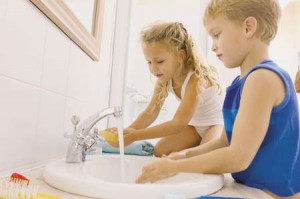 1. Proper hand washing decreases absenteeism in daycare centers and elementary schools. Young children rarely wash their hands unless reminded, and generally do so incorrectly unless supervised. Disease-causing organisms remain viable on toilet flush handles, doorknobs and toys, for example, for many hours, sometimes days. Children are especially susceptible to many of the respiratory and intestinal illnesses that are spread by hands.
1. Proper hand washing decreases absenteeism in daycare centers and elementary schools. Young children rarely wash their hands unless reminded, and generally do so incorrectly unless supervised. Disease-causing organisms remain viable on toilet flush handles, doorknobs and toys, for example, for many hours, sometimes days. Children are especially susceptible to many of the respiratory and intestinal illnesses that are spread by hands.
2. Soap/water rids hands of organisms better than other substances. And soap is safe. With rare exceptions, the use of the same bar by many individuals does not spread organisms. Soap does not lend itself to organisms multiplying. Liquid soaps may be marginally safer in this respect. Accidental eating or drinking soap by young children may cause upset stomachs but no serious toxic effects.
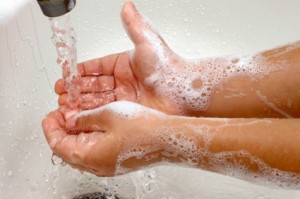 3. Teach children to use soap correctly. Soap does not kill organisms. Soap plus the friction of rubbing hands together loosens organisms and grime on the skin. Water flushes the debris away, the more water the better. The process should take at least 30 seconds, the time it takes to sing “Happy Birthday” twice. In public bathrooms especially, teach kids to use disposable towels to turn off faucets.
3. Teach children to use soap correctly. Soap does not kill organisms. Soap plus the friction of rubbing hands together loosens organisms and grime on the skin. Water flushes the debris away, the more water the better. The process should take at least 30 seconds, the time it takes to sing “Happy Birthday” twice. In public bathrooms especially, teach kids to use disposable towels to turn off faucets.
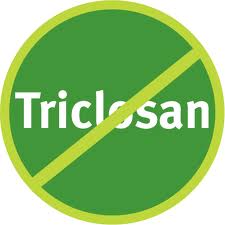 4. Antibacterial/antiseptic substances do not increase the effectiveness of soaps and hand sanitizers. Especially avoid products containing triclosan, says the Centers for Disease Control. This substance is found in numerous soaps, hand sanitizers, toothpastes and other everyday consumer/sanitary products. Studies suggest that triclosan is potentially harmful to both humans and animals. Many studies are underway.
4. Antibacterial/antiseptic substances do not increase the effectiveness of soaps and hand sanitizers. Especially avoid products containing triclosan, says the Centers for Disease Control. This substance is found in numerous soaps, hand sanitizers, toothpastes and other everyday consumer/sanitary products. Studies suggest that triclosan is potentially harmful to both humans and animals. Many studies are underway.
5. Use hand sanitizers when soap is not available. Innumerable products with umpteen ingredients and exaggerated claims make healthy choices difficult. Some studies suggest that optimal hand sanitizers may be as or more effective than soap in ridding hands of disease-causing microorganisms. Moreover, sanitizers do not dry and irritate skin more than soap, even when used frequently, and even when used on the skin of young children. Many hand sanitizers contain emollients.
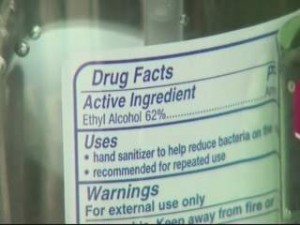 6. The most effective sanitizers contain between 60 and 70% ethyl alcohol. This kills organisms by disintegrating their outer coating. Most of the popular products contain 62%. Products that contain different percentages of ethyl alcohol, different alcohols, or “natural products only” are less effective or inadequately studied. While some products labeled “hand wipes” and “hand rubs” contain 62% alcohol and are quite effective, others are merely packaged wet towels with no antimicrobial ingredients whatsoever. Read labels.
6. The most effective sanitizers contain between 60 and 70% ethyl alcohol. This kills organisms by disintegrating their outer coating. Most of the popular products contain 62%. Products that contain different percentages of ethyl alcohol, different alcohols, or “natural products only” are less effective or inadequately studied. While some products labeled “hand wipes” and “hand rubs” contain 62% alcohol and are quite effective, others are merely packaged wet towels with no antimicrobial ingredients whatsoever. Read labels.
7. Hand sanitizers are less effective when hands are visibly dirty. Alcohol must contact each organism directly to kill it. Dirt shields the organisms from the alcohol. (We found no suggestions on how to clean visibly dirty hands with sanitizers. If you know any such suggestions, please let us know. We will notify our readers.)
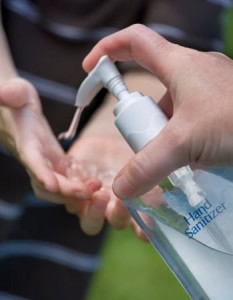 8. Use alcohol-based sanitizers correctly. Remove bracelet and watches. Apply to the palm of one hand. Rub the hands together, covering all surfaces of the hands, fingers, and wrists. Add more sanitizer, if necessary. Continue to rub hands together until the hands are dry. This generally takes approximately 20 to 30 seconds. If hands become dry sooner, you probably have not applied sufficient sanitizer.
8. Use alcohol-based sanitizers correctly. Remove bracelet and watches. Apply to the palm of one hand. Rub the hands together, covering all surfaces of the hands, fingers, and wrists. Add more sanitizer, if necessary. Continue to rub hands together until the hands are dry. This generally takes approximately 20 to 30 seconds. If hands become dry sooner, you probably have not applied sufficient sanitizer.
9. Sanitizers are safe for infants/toddlers. Virtually no alcohol is absorbed through the skin; alcohol evaporates too rapidly. This also prevents infants from ingesting significant amounts through licking their hands/fingers. There are no known serious medical events from accidentally ingesting sanitizers. Likely, the bad taste is a deterrent. However, take care: sanitizer bottles do not have safety caps as do most substances that children may ingest.
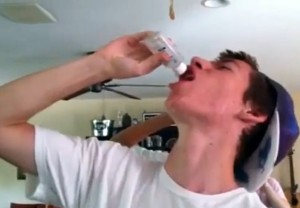 10. Be aware that teenagers use hand sanitizers to get high. In a recent year, American ERs reported hundreds of cases of hand sanitizer ingestions by teenagers sufficiently serious to require medical treatment. Two ounces of a 62% ethyl alcohol-containing sanitizer is equivalent to four shots of vodka. Websites provide teenagers with instructions on how to make hand sanitizers more palatable. Hand sanitizers are also flammable. In Oregon, high schools students “fooling around” with sanitizers accidentally burned down a large section of their high school.
10. Be aware that teenagers use hand sanitizers to get high. In a recent year, American ERs reported hundreds of cases of hand sanitizer ingestions by teenagers sufficiently serious to require medical treatment. Two ounces of a 62% ethyl alcohol-containing sanitizer is equivalent to four shots of vodka. Websites provide teenagers with instructions on how to make hand sanitizers more palatable. Hand sanitizers are also flammable. In Oregon, high schools students “fooling around” with sanitizers accidentally burned down a large section of their high school.
For more tips or to ask Dr. Neumann please visit Dr. Neumann’s Kids Travel Doc to keep your family safe and healthy for travel and outdoor activities.
- 5-Winter Themed Bone Chilling Survival Movies on Netflix - 12/29/2017
- 7 Best Scary Movies for Kids that are Streaming on NETFLIX - 10/13/2017
- Watch P. King Duckling on Disney Junior + Giveaway - 06/26/2017


Thank you SO much for this post. As a soon-to-be nurse, one of the important basics we have learned is hand hygiene. It is amazing how many infections can be prevented with simple hand hygiene, whether you are in a hospital, school, or home. It is an easy intervention that will help keep everyone safe.
Thank you for this… my daughter already sings the happy birthday song but I had no idea that she should be using a towel to shut off the water.
I have checked our anti-bacterial hand wash soap and it does contain Triclosan. I am going to get rid of it ASAP. Thanks for posting this…
1